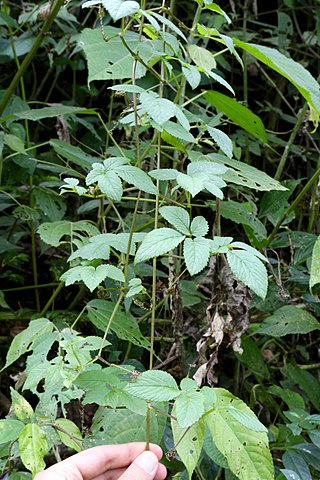
The Salicaceae is the willow family of flowering plants. The traditional family included the willows, poplar, aspen, and cottonwoods. Genetic studies summarized by the Angiosperm Phylogeny Group (APG) have greatly expanded the circumscription of the family to contain 56 genera and about 1220 species, including the Scyphostegiaceae and many of the former Flacourtiaceae.

The Flacourtiaceae is a defunct family of flowering plants whose former members have been scattered to various families, mostly to the Achariaceae and Salicaceae. It was so vaguely defined that hardly anything seemed out of place there and it became a dumping ground for odd and anomalous genera, gradually making the family even more heterogeneous. In 1975, Hermann Sleumer noted that "Flacourtiaceae as a family is a fiction; only the tribes are homogeneous."

The Passifloraceae are a family of flowering plants, containing about 750 species classified in around 27 genera.

Peridiscaceae is a family of flowering plants in the order Saxifragales. Four genera comprise this family: Medusandra, Soyauxia, Peridiscus, and Whittonia., with a total of 12 known species. It has a disjunct distribution, with Peridiscus occurring in Venezuela and northern Brazil, Whittonia in Guyana, Medusandra in Cameroon, and Soyauxia in tropical West Africa. Whittonia is possibly extinct, being known from only one specimen collected below Kaieteur Falls in Guyana. In 2006, archeologists attempted to rediscover it, however, it proved unsuccessful.
PlowmanianthusFaden & C.R.Hardy is a genus of plants with 5 species and 2 subspecies in the family Commelinaceae. The genus is distributed from Panama to Amazonian Peru and Brazil.

Reldia is a genus of plants in the family Gesneriaceae. They are also in the Beslerieae tribe.

Jaques Étienne Gay was a Swiss-French botanist, civil servant, collector and taxonomist. His name is associated with plants in standardised botanical nomenclature, e.g. Crocus sieberi J.Gay. He was the most famous of the students of botanist Jean François Aimée Gaudin with whom he began collecting plants at the age of 14. He was married to Rosalie Nillion.
Aphaerema was formerly a genus of flowering plants in the Flacourtiaceae, consisting of one species of small shrubs, Aphaerema spicata, which is native to Brazil and Argentina. Later studies indicated that Aphaerema should be classified in the willow family, Salicaceae, and combined with the genus Abatia. Unfortunately, because the name Abatia spicata was already used, the species was given the new name Abatia angeliana, in honor of Brazilian botanist João Angely. Aphaerema is one of the few groups of Salicaceae with opposite leaves.

The genus Barteria is in the family Passifloraceae in the major group angiosperms. It contains 8 described species, however, only 6 are accepted.

Prockia is a genus of flowering plants in the family Salicaceae. It consists of approximately six species of shrubs and small trees native to the West Indies, Mexico, Central America, and South America. Its type species, Prockia crucis, is highly polymorphic and has a broad distribution, from Mexico and the West Indies to Uruguay and northern Argentina.

Stapfiella is a genus of flowering plants belonging to the family Passifloraceae. It is also in the Subfamily Turneroideae.
Viridivia is a monotypic genus of flowering plants belonging to the family Passifloraceae. It only contain one known species, Viridivia suberosa. It is also in the subfamily Passifloroideae and tribe Paropsieae.

Tourrettia is a monotypic genus of flowering plants belonging to the family Bignoniaceae. It only contains one known species, Tourrettia lappacea(L'Hér.) Willd. The genus of Tourrettia has 2 known synonyms, DombeyaL'Hér. and MedicaCothen. It is also in Tribe Tourrettieae.
Tisonia is a genus of flowering plants belonging to the family Salicaceae. It is also in the subfamily Salicoideae and tribe Saliceae.

Dilkea is a genus of flowering plants belonging to the family Passifloraceae.
Kuhlmanniodendron is a genus of flowering plants belonging to the family Achariaceae.
Schlechterina is a monotypic genus of flowering plants belonging to the family Passifloraceae. The only knowns species is Schlechterina mitostemmatoides.
Ruizodendron is a monotypic genus of flowering plants belonging to the family Annonaceae. It is part of Malmeoideae subfamily and Malmeeae tribe. The only known species is Ruizodendron ovale.
Hanburia is a genus of plants in the tribe Sicyoeae of the gourd family, Cucurbitaceae. Its native range is from Mexico to Venezuela and Peru. It is found in the countries of Colombia, Costa Rica, Ecuador, Guatemala, Honduras, Mexico, Panamá, Peru and Venezuela.
Poortmannia is a genus of flowering plants belonging to the family Solanaceae. It is also in Solanoideae subfamily, tribe Solandreae Miers and also subtribe Juanulloinae. The genus has only one known species, Poortmannia speciosaDrake.











